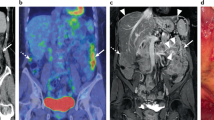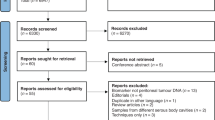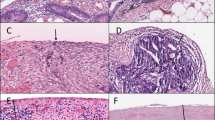Abstract
Image-guided core biopsy of the omentum and peritoneum was described a decade ago and has since been validated in a number of large studies as a safe and effective means of providing a tissue diagnosis in patients with undiagnosed peritoneal disease. Some studies have addressed its ability for determining whether peritoneal infiltration and/or omental masses in patients with prior malignancy represent recurrent disease or a new disease process. Others have focused on the specific issue of women suspected to have advanced peritoneal carcinomatosis from ovarian or primary peritoneal cancer where the primary management of the patient is directed by the tissue diagnosis. The initial management of many of these women, especially those with advanced disease or substantial comorbidity, is with primary chemotherapy. With current clinical trials for ovarian cancer directed to specific morphological subtypes of the disease, image-guided core biopsy offers a rapid and well tolerated nonsurgical means of providing this information. In this Review, we discuss the technique and its clinical applications, and critically examine the currently available alternative options.
Key Points
-
Image-guided core biopsy (IGCB) has been established as a safe, well tolerated and effective intervention for patients with undiagnosed peritoneal carcinomatosis
-
Clinical developments in the management of ovarian cancer suggest that neoadjuvant chemotherapy will become a more widespread primary treatment, and IGCB can provide a firm histological diagnosis to direct therapy
-
Forthcoming clinical trials for ovarian cancer will focus on chemotherapy targeted at specific subtypes of the disease, and IGCB can provide diagnostic material to assess these subtypes
-
If women with a history of cancer develop peritoneal carcinomatosis, it is vital to distinguish recurrence from a new disease process, which can be facilitated by IGCB
This is a preview of subscription content, access via your institution
Access options
Subscribe to this journal
Receive 12 print issues and online access
$209.00 per year
only $17.42 per issue
Buy this article
- Purchase on Springer Link
- Instant access to full article PDF
Prices may be subject to local taxes which are calculated during checkout








Similar content being viewed by others
References
Jennings, P. E., Donald, J. J., Coral, A., Rode, J. & Lees, W. R. Ultrasound-guided core biopsy. Lancet 1, 1369–1371 (1989).
Silverman, S. G., Mueller, P. R., Pinkney, L. P., Koenker, R. M. & Seltzer, S. E. Predictive value of image-guided adrenal biopsy: analysis of results of 101 biopsies. Radiology 187, 715–718 (1993).
Ben-Yehuda, D. et al. Image-guided core-needle biopsy in malignant lymphoma: experience with 100 patients that suggests the technique is reliable. J. Clin. Oncol. 14, 2431–2434 (1996).
Pombo, F., Rodriguez, E., Martin, R. & Lago, M. CT-guided core-needle biopsy in omental pathology. Acta Radiol. 38, 978–981 (1997).
Spencer, J. A. et al. Peritoneal carcinomatosis: image-guided peritoneal core biopsy for tumor type and patient care. Radiology 221, 173–177 (2001).
Hewitt, M. J. et al. Women with peritoneal carcinomatosis of unknown origin: efficacy of image-guided biopsy to determine site-specific diagnosis. BJOG 114, 46–50 (2007).
Griffin, N. et al. Image-guided biopsy in patients with suspected ovarian carcinoma: a safe and effective technique? Eur. Radiol. 19, 230–235 (2009).
Souza, F. F., Mortelé, K. J., Cibas, E. S., Erturk, S. M. & Silverman, S. G. Predictive value of percutaneous imaging-guided biopsy of peritoneal and omental masses: results in 111 patients. AJR Am. J. Roentgenol. 192, 131–136 (2009).
van der Burg, M. E. et al. The effect of debulking surgery after induction chemotherapy on the prognosis in advanced epithelial ovarian cancer. Gynecological Cancer Cooperative Group of the European Organization for Research and Treatment of Cancer. N. Engl. J. Med. 332, 629–634 (1995).
Stafford-Johnson, D. B., Bree, R. L., Francis, I. R. & Korobkin, M. CT appearance of primary papillary serous carcinoma of the peritoneum. AJR Am. J. Roentgenol. 171, 687–689 (1998).
Zissin, R. et al. Primary serous papillary carcinoma of the peritoneum: CT findings. Clin. Radiol. 56, 740–745 (2001).
Strnad, C. M. et al. Peritoneal carcinomatosis of unknown primary site in women. A distinctive subset of adenocarcinoma. Ann. Intern. Med. 111, 213–217 (1989).
Della-Fiorentina, S. A., Jaworski, R. C., Crandon, A. J. & Harnett, P. R. Primary peritoneal carcinoma: a treatable subset of patients with adenocarcinoma of unknown primary. Aust. N. Z. J. Surg. 66, 124–125 (1996).
Sadeghi, B. et al. Peritoneal carcinomatosis from non-gynecologic malignancies: results of the EVOCAPE 1 multicentric prospective study. Cancer 88, 358–363 (2000).
Kauff, N. D. et al. Risk-reducing salpingo-oophorectomy in women with a BRCA1 or BRCA2 mutation. N. Engl. J. Med. 346, 1609–1615 (2002).
Hewitt, M. J. et al. Image-guided biopsy in women with breast cancer presenting with peritoneal carcinomatosis. Int. J. Gynecol. Cancer 16 (Suppl. 1), 108–110 (2006).
Trimbos, J. B. et al. International Collaborative Ovarian Neoplasm trial 1 and Adjuvant ChemoTherapy In Ovarian Neoplasm trial: two parallel randomized phase III trials of adjuvant chemotherapy in patients with early-stage ovarian carcinoma. J. Natl Cancer Inst. 95, 105–112 (2003).
Trimbos, J. B. et al. Impact of adjuvant chemotherapy and surgical staging in early-stage ovarian carcinoma: European Organisation for Research and Treatment of Cancer-Adjuvant ChemoTherapy in Ovarian Neoplasm trial. J. Natl Cancer Inst. 95, 113–125 (2003).
Berezowski, K., Stastny, J. F. & Kornstein, M. J. Cytokeratins 7 and 20 and carcinoembryonic antigen in ovarian and colonic carcinoma. Mod. Pathol. 9, 426–429 (1996).
Longatto Filho, A. et al. Adenocarcinoma in females detected in serous effusions. Cytomorphologic aspects and immunocytochemical reactivity to cytokeratins 7 and 20. Acta Cytol. 41, 961–971 (1997).
Tot, T. Cytokeratins 20 and 7 as biomarkers: usefulness in discriminating primary from metastatic adenocarcinoma. Eur. J. Cancer 38, 758–763 (2002).
O'Neill, C. J. et al. High-grade ovarian serous carcinoma exhibits significantly higher p16 expression than low-grade serous carcinoma and serous borderline tumour. Histopathology 50, 773–779 (2007).
O'Neill, C. J., Deavers, M. T., Malpica, A., Foster, H. & McCluggage, W. G. An immunohistochemical comparison between low-grade and high-grade ovarian serous carcinomas: significantly higher expression of p53, MIB1, BCL2, HER-2/neu, and C-KIT in high-grade neoplasms. Am. J. Surg. Pathol. 29, 1034–1041 (2005).
McCluggage, W. G. WT1 is of value in ascertaining the site of origin of serous carcinomas within the female genital tract. Int. J. Gynecol. Pathol. 23, 97–99 (2004).
Ji, H., Isacson, C., Seidman, J. D., Kurman, R. J. & Ronnett, B. M. Cytokeratins 7 and 20, Dpc4, and MUC5AC in the distinction of metastatic mucinous carcinomas in the ovary from primary ovarian mucinous tumors: Dpc4 assists in identifying metastatic pancreatic carcinomas. Int. J. Gynecol. Pathol. 21, 391–400 (2002).
Werling, R. W., Yaziji, H., Bacchi, C. E. & Gown, A. M. CDX2, a highly sensitive and specific marker of adenocarcinomas of intestinal origin: an immunohistochemical survey of 476 primary and metastatic carcinomas. Am. J. Surg. Pathol. 27, 303–310 (2003).
National Institute for Health and Clinical Excellence. Cetuximab for the first-line treatment of metastatic colorectal cancer [online], (2009).
National Institute for Health and Clinical Excellence. Guidance on the use of trastuzumab for the treatment of advanced breast cancer [online], (2002).
National Institute for Health and Clinical Excellence. Diagnosis and management of metastatic malignant disease of unknown primary origin: evidence review [online], (2010).
National Institute for Health and Clinical Excellence. Metastatic malignant disease of unknown primary origin: full guideline [online], (2010).
International Standard Randomised Controlled Trial Number Register ISRCTN74802813—a randomised feasibility trial to determine the impact of timing of surgery and chemotherapy in newly diagnosed patients with advanced epithelial ovarian, primary peritoneal, or fallopian tube carcinoma [online], (2010).
Mayall, F., Chang, B. & Darlington, A. A review of 50 consecutive cytology cell block preparations in a large general hospital. J. Clin. Pathol. 50, 985–990 (1997).
Nathan, N. A., Narayan, E., Smith, M. M. & Horn, M. J. Cell block cytology. Improved preparation and its efficacy in diagnostic cytology. Am. J. Clin. Pathol. 114, 599–606 (2000).
Fowler, L. J. & Lachar, W. A. Application of immunohistochemistry to cytology. Arch. Pathol. Lab. Med. 132, 373–383 (2008).
Gynecologic Cancer Intergroup. Randomized phase III trial of paclitaxel plus carboplatin (TC) therapy versus irinotecan plus cisplatin (CPT-P) therapy as a first line chemotherapy for clear cell carcinoma of the ovary [online], (2009).
International Standard Randomised Controlled Trial Number Register. ISRCTN83438782—mEOC: a multicentre randomised Gynaecologic Cancer Intergroup (GCIG) trial comparing oxaliplatin plus capecitabine versus carboplatin plus paclitaxel in patients with previously untreated mucinous ovarian (mEOC) cancer [online], (2010).
Ibeanu, O. A. & Bristow, R. E. Predicting the outcome of cytoreductive surgery for advanced ovarian cancer: a review. Int. J. Gynecol. Cancer 20 (Suppl. 1), S1–S11 (2010).
Hunter, R. W., Alexander, N. D. & Soutter, W. P. Meta-analysis of surgery in advanced ovarian carcinoma: is maximum cytoreductive surgery an independent determinant of prognosis? Am. J. Obstet. Gynecol. 166, 504–511 (1992).
Vergote, I., Amant, F. & Van Gorp, T. Role of diaphragmatic surgery in 69 patients with ovarian carcinoma. Int. J. Gynecol. Cancer 19, 481 (2009).
Vergote, I. et al. Neoadjuvant chemotherapy or primary surgery in stage IIIC or IV ovarian cancer. N. Engl. J. Med. 363, 943–953 (2010).
Deo, S. V. et al. Neoadjuvant chemotherapy followed by surgical cytoreduction in advanced epithelial ovarian cancer. Indian J. Cancer 43, 117–121 (2006).
Hou, J. Y. et al. Neoadjuvant chemotherapy lessens surgical morbidity in advanced ovarian cancer and leads to improved survival in stage IV disease. Gynecol. Oncol. 105, 211–217 (2007).
Bilici, A. et al, Neoadjuvant chemotherapy followed by interval cytoreductive surgery in patients with unresectable, advanced stage epithelial ovarian cancer: a single centre experience. Arch. Gynecol. Obstet. 282, 417–425 (2010).
Author information
Authors and Affiliations
Contributions
All the authors contributed to discussion of content for the article, researched data to include in the manuscript, reviewed and edited the manuscript before submission, and revised the manuscript in response to the peer-reviewers' comments.
Corresponding author
Ethics declarations
Competing interests
The authors declare no competing financial interests.
Rights and permissions
About this article
Cite this article
Spencer, J., Weston, M., Saidi, S. et al. Clinical utility of image-guided peritoneal and omental biopsy. Nat Rev Clin Oncol 7, 623–631 (2010). https://doi.org/10.1038/nrclinonc.2010.155
Published:
Issue Date:
DOI: https://doi.org/10.1038/nrclinonc.2010.155



